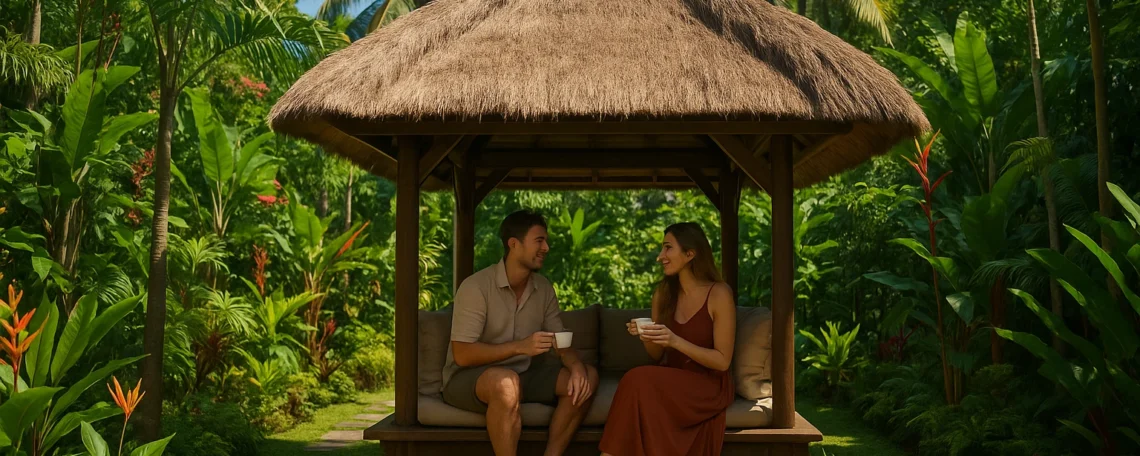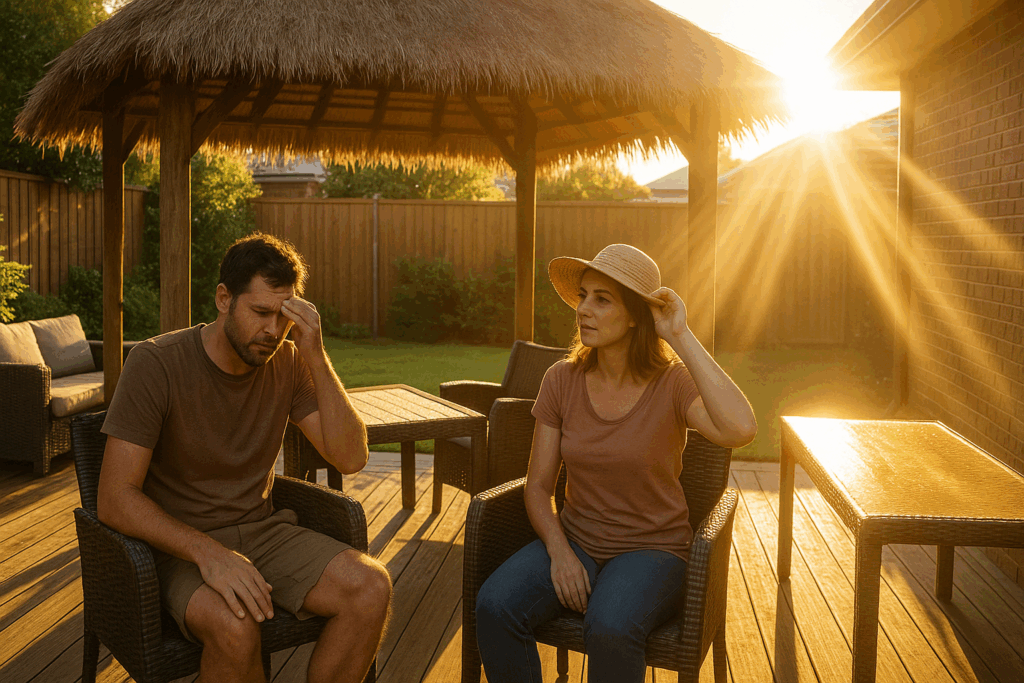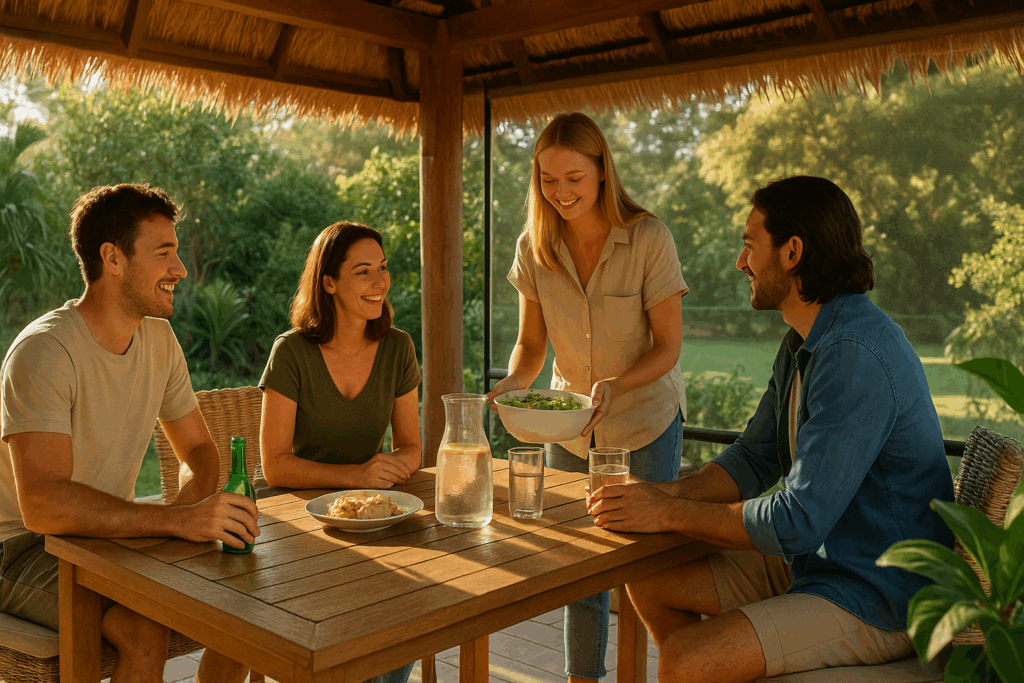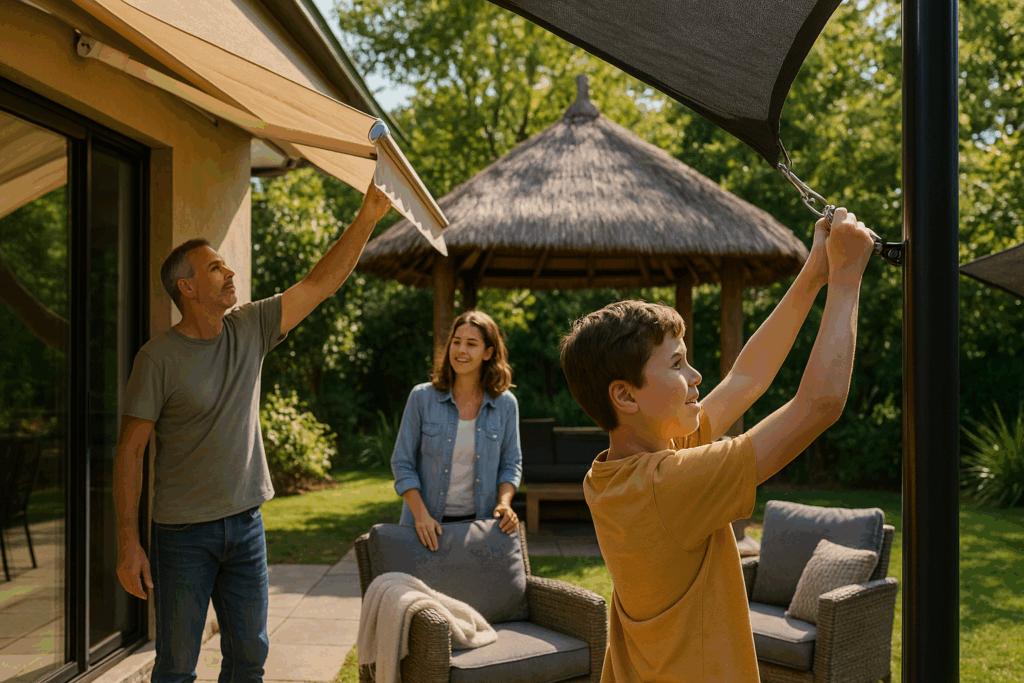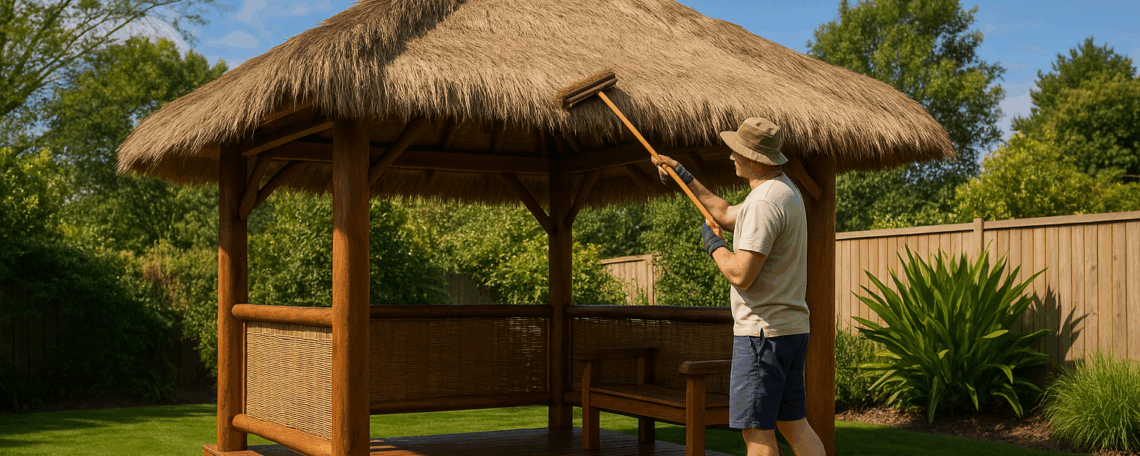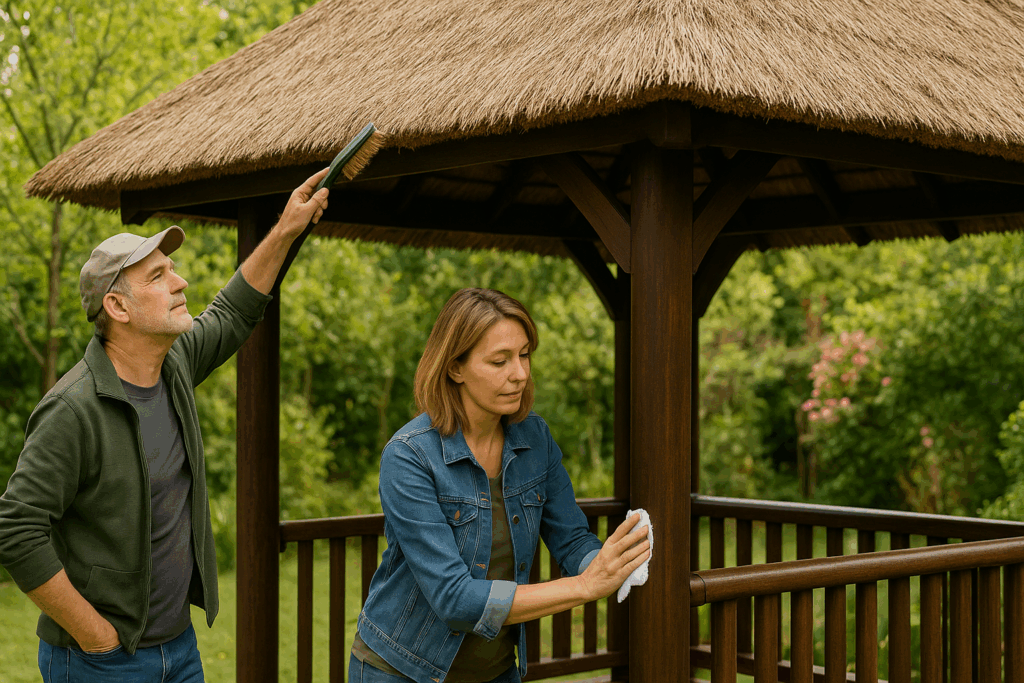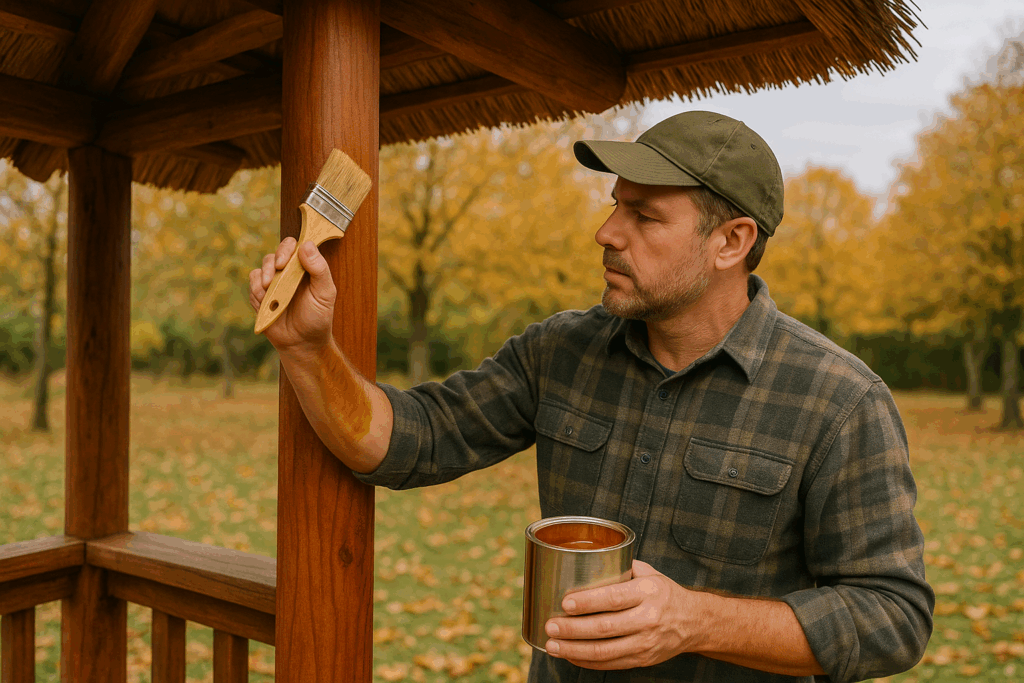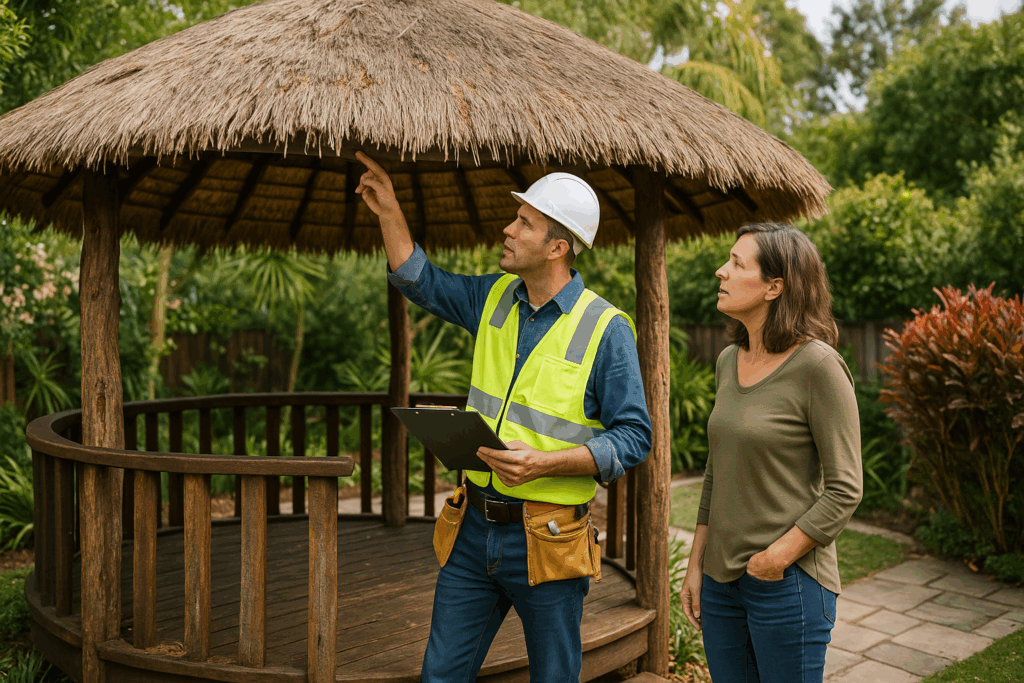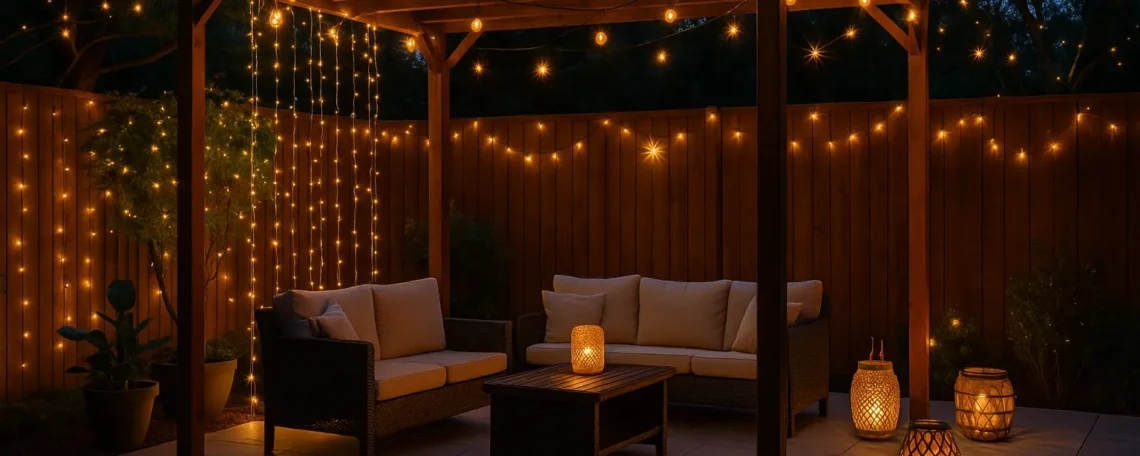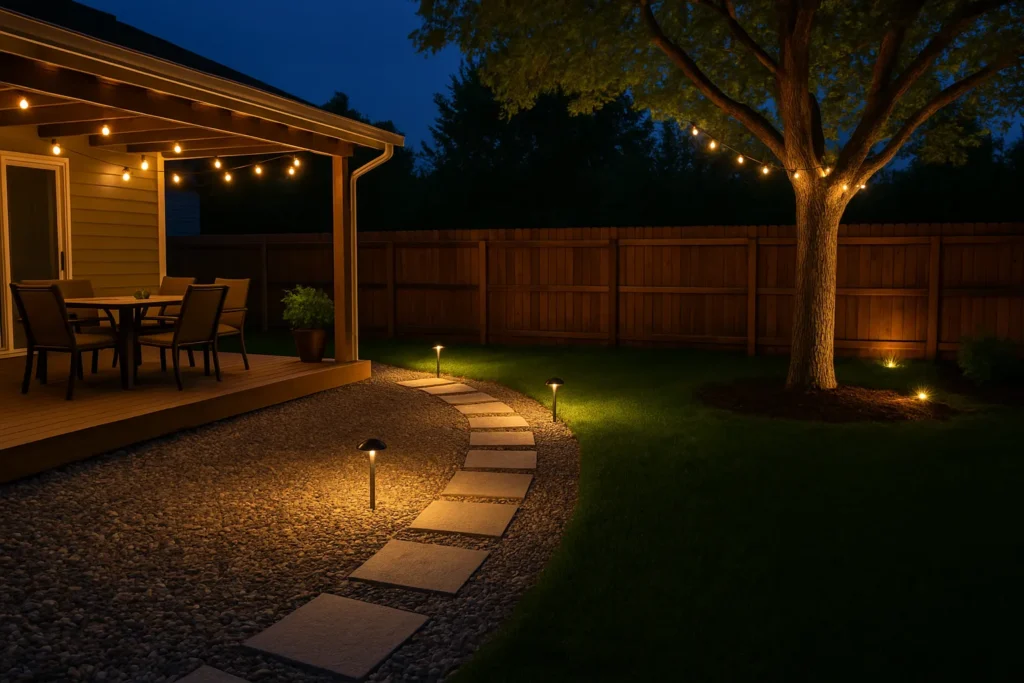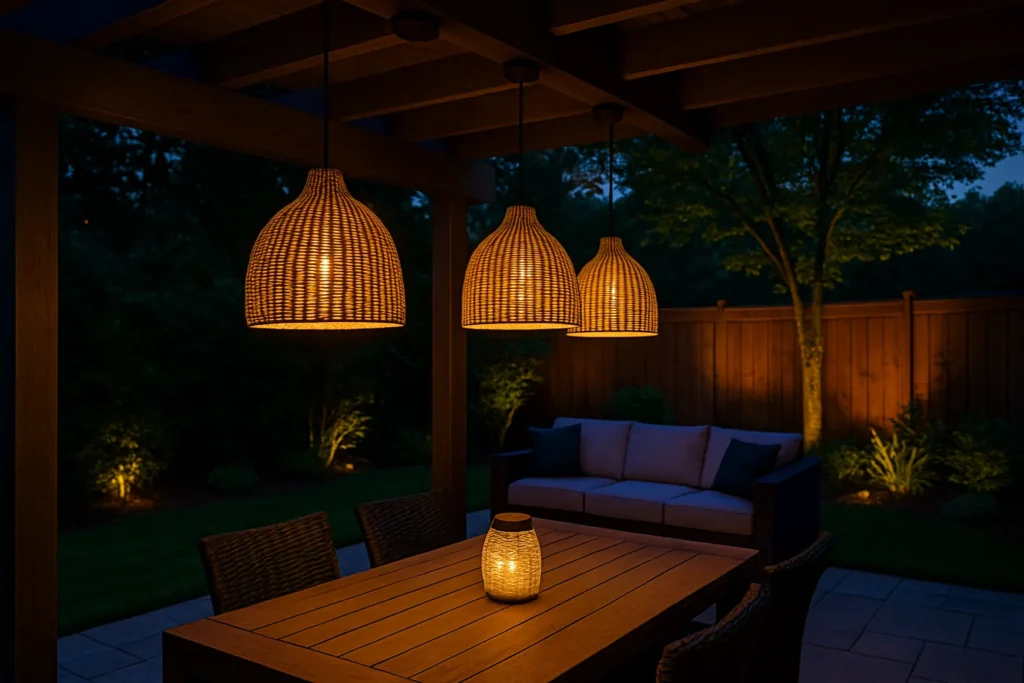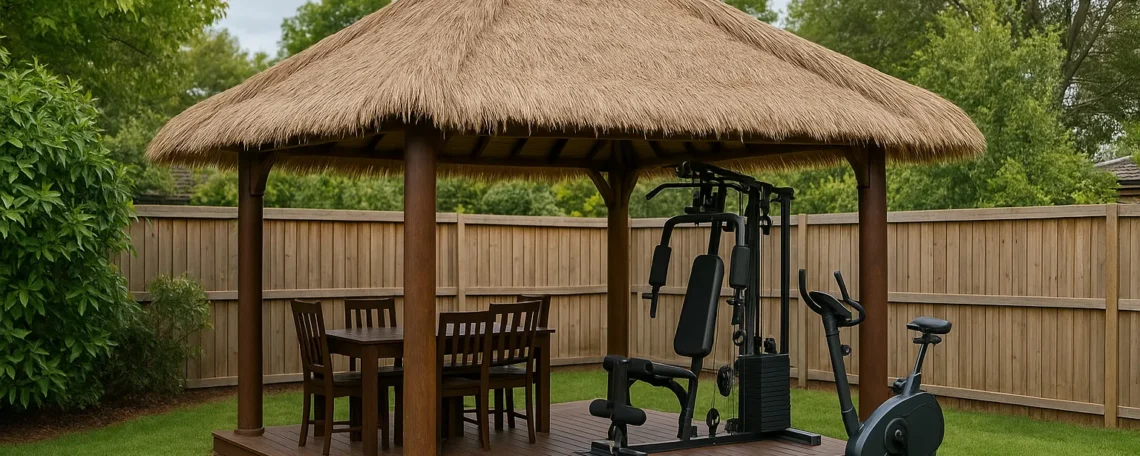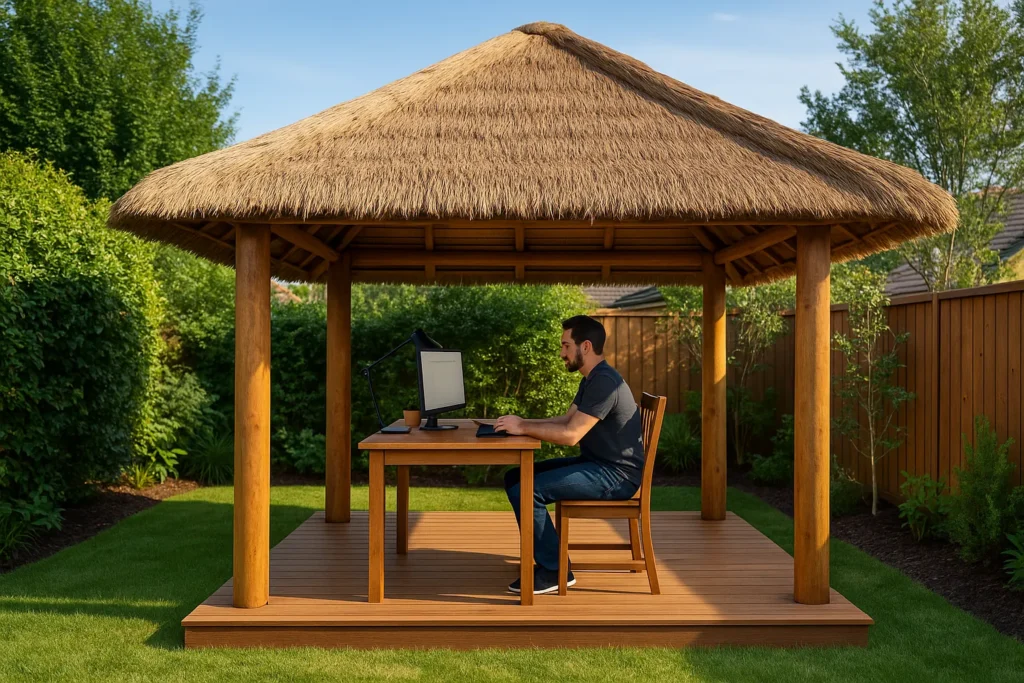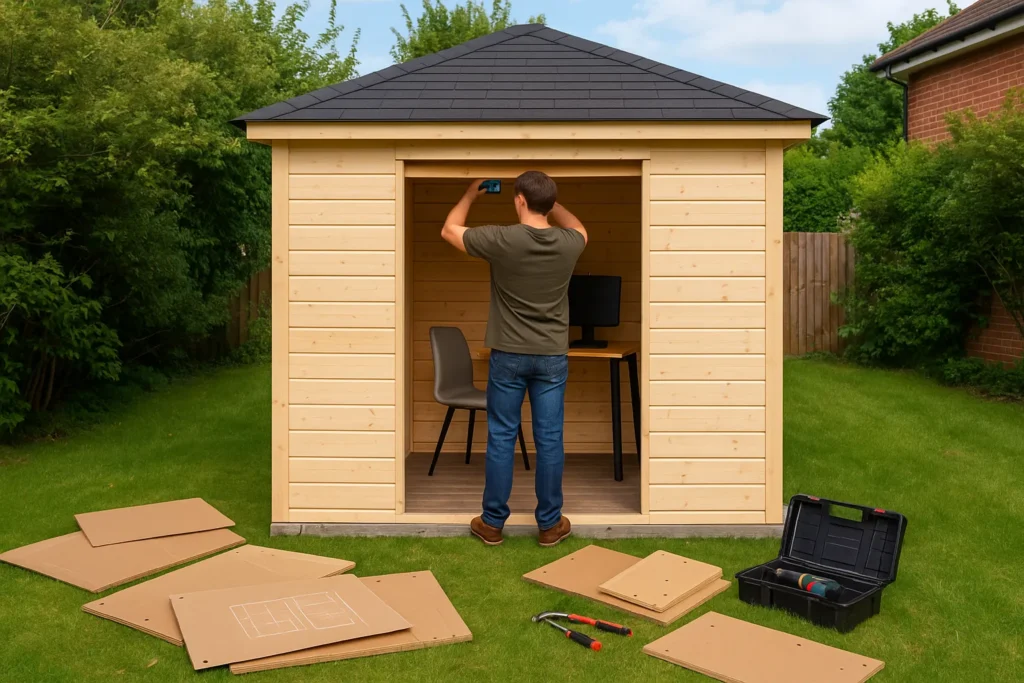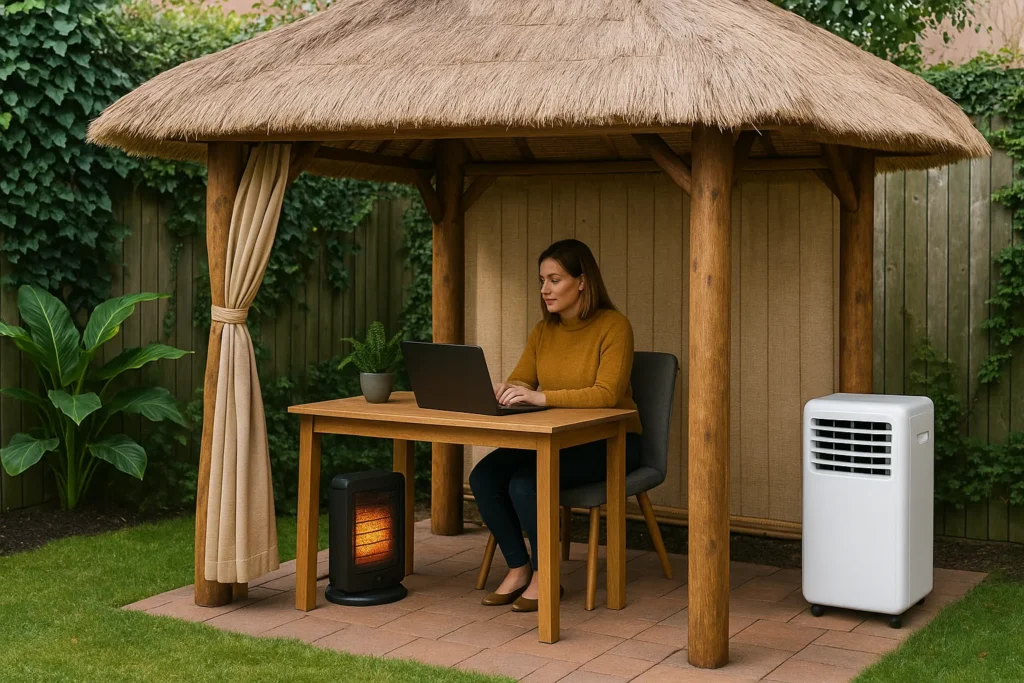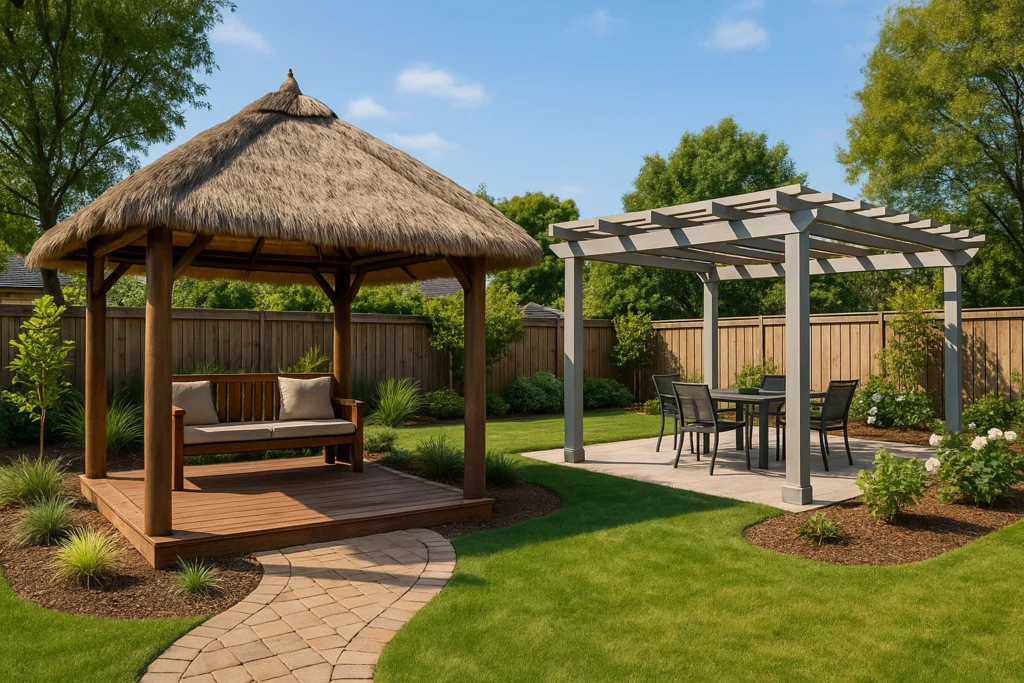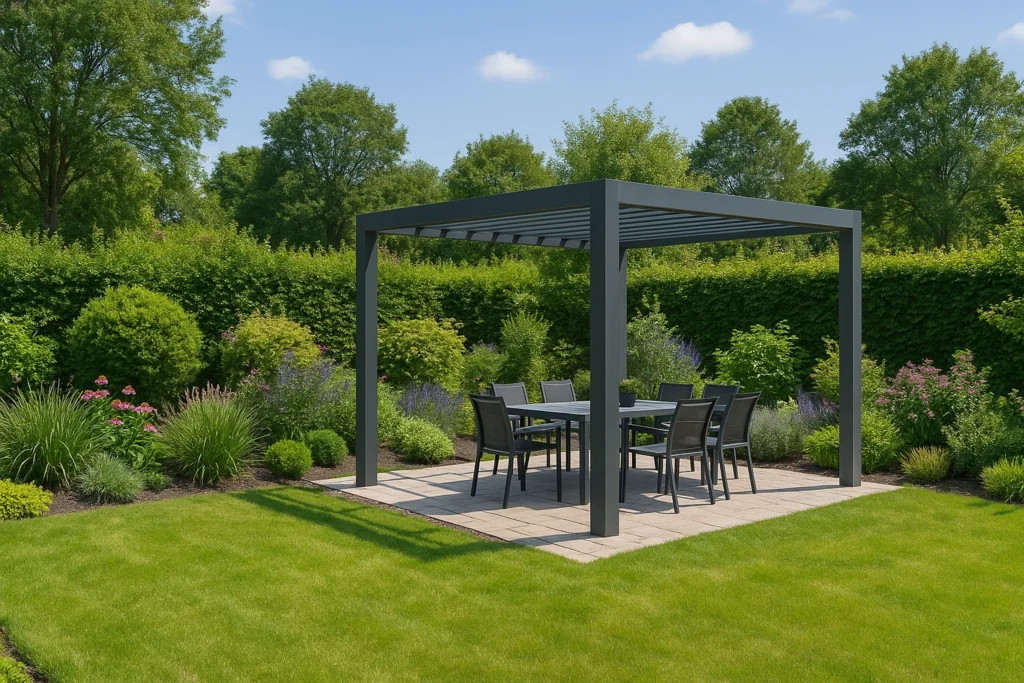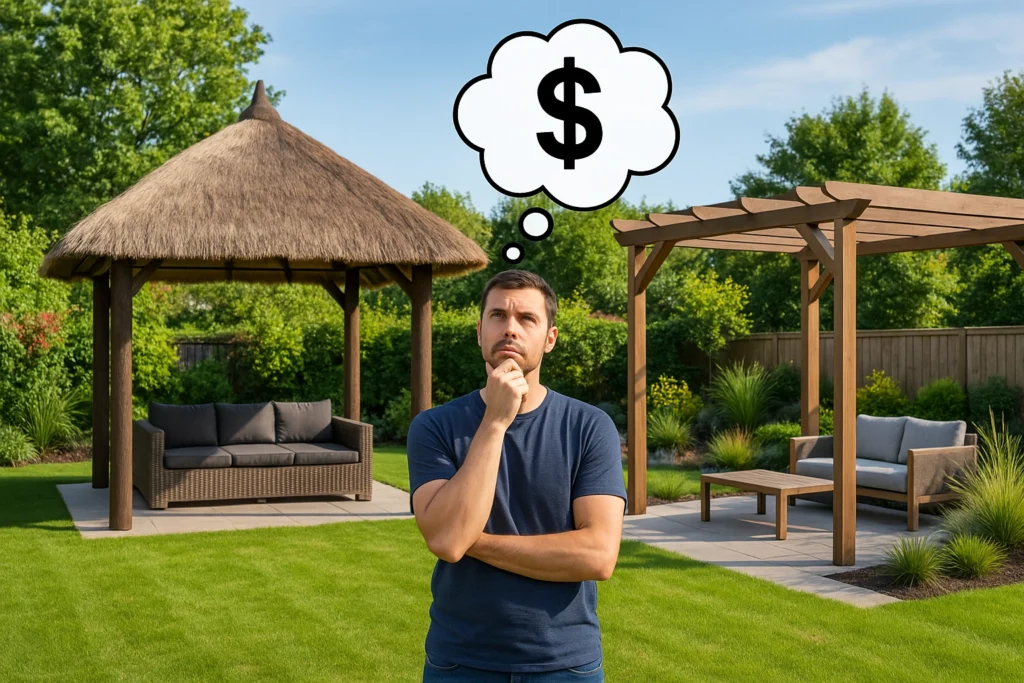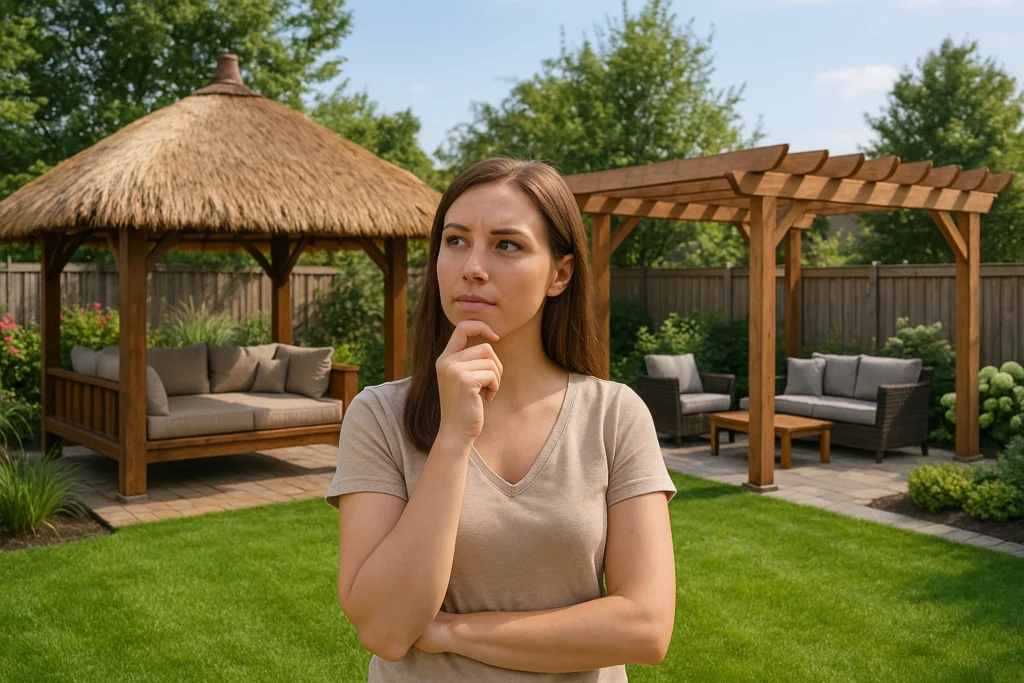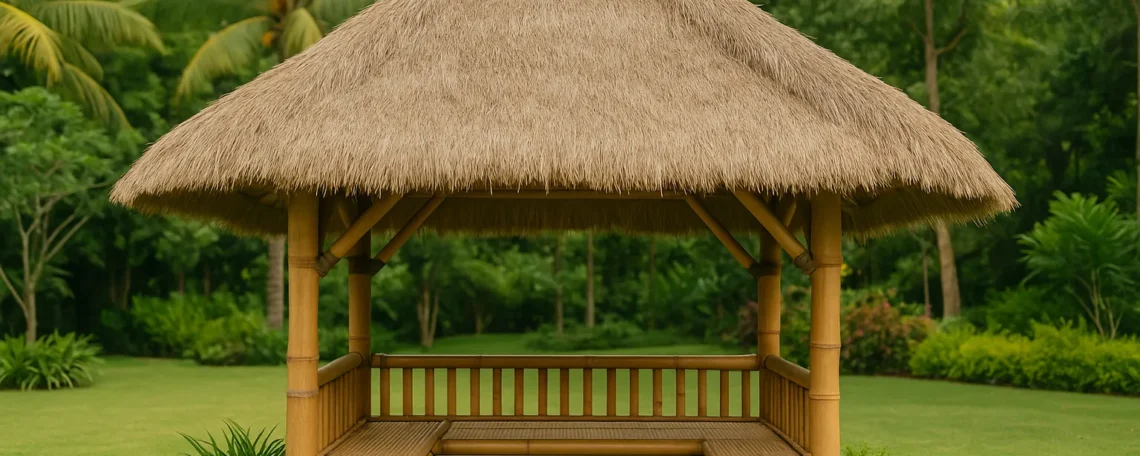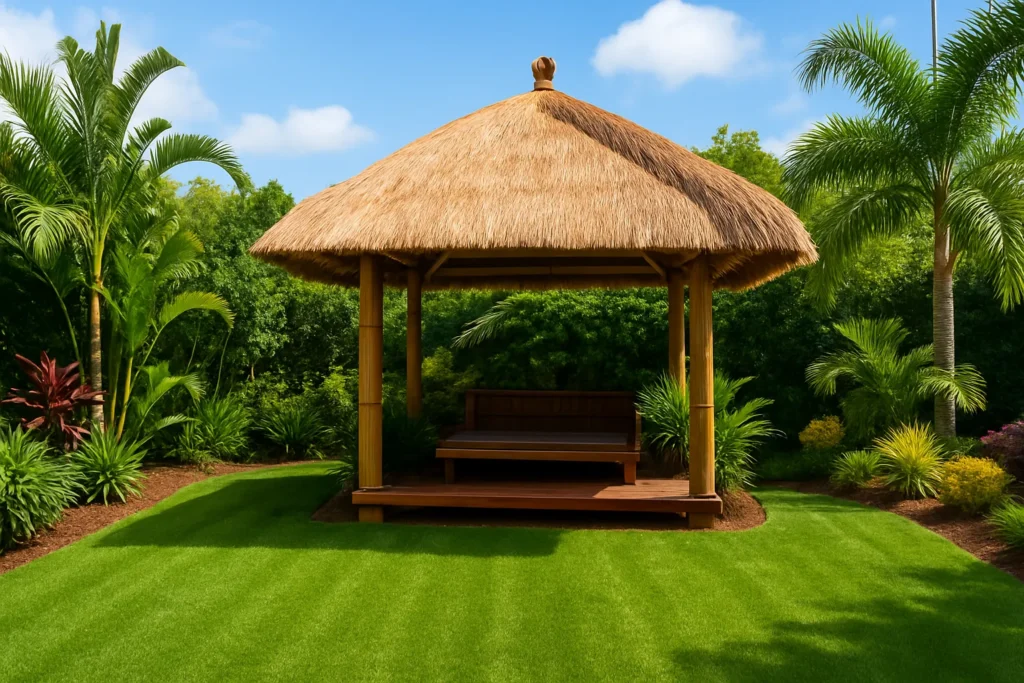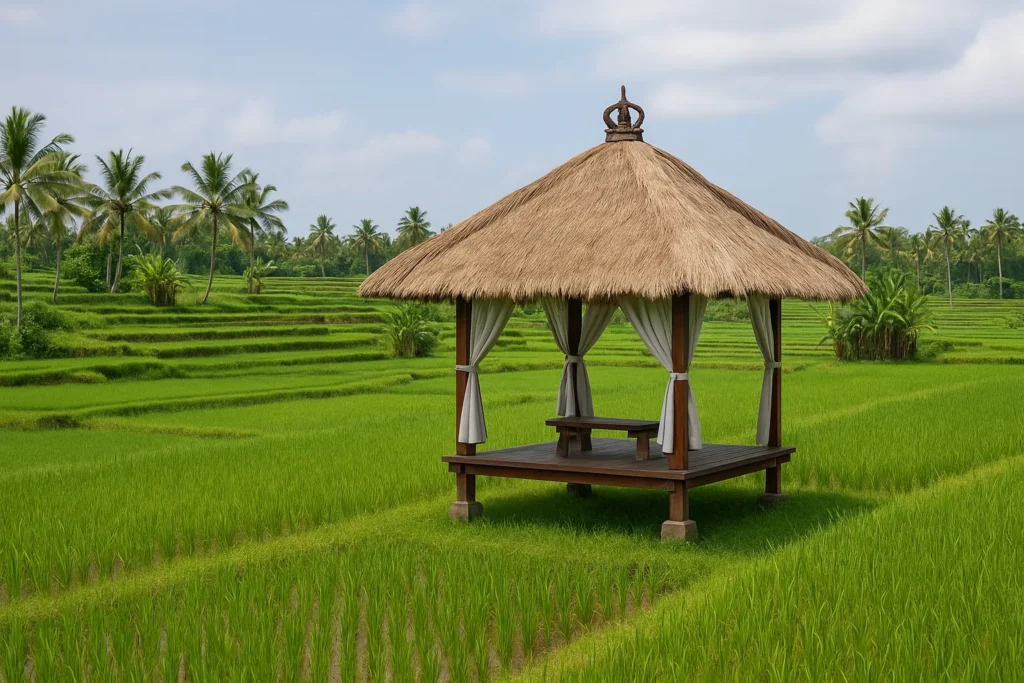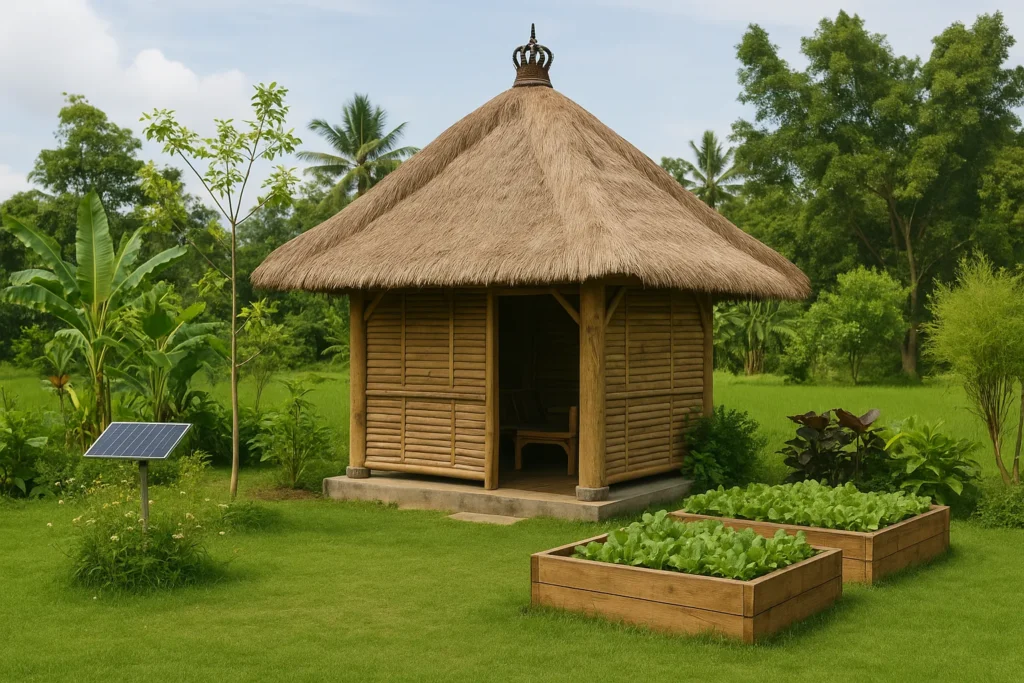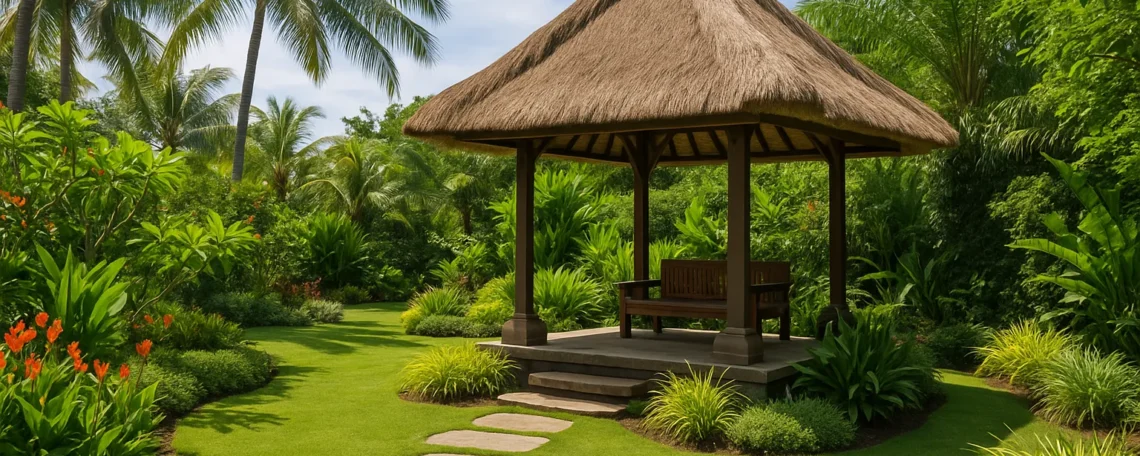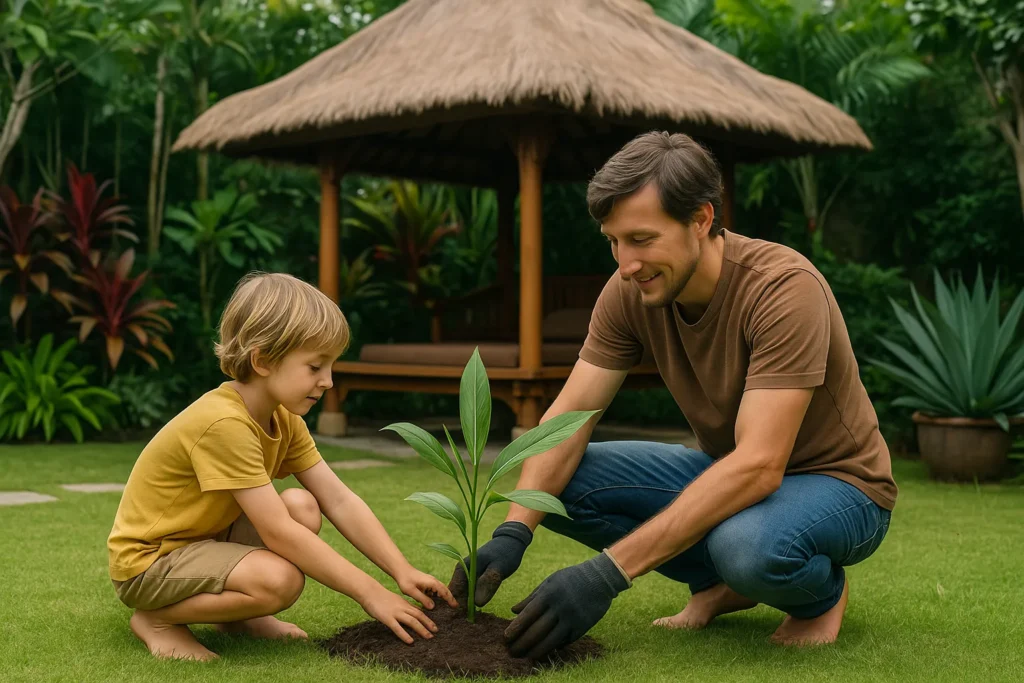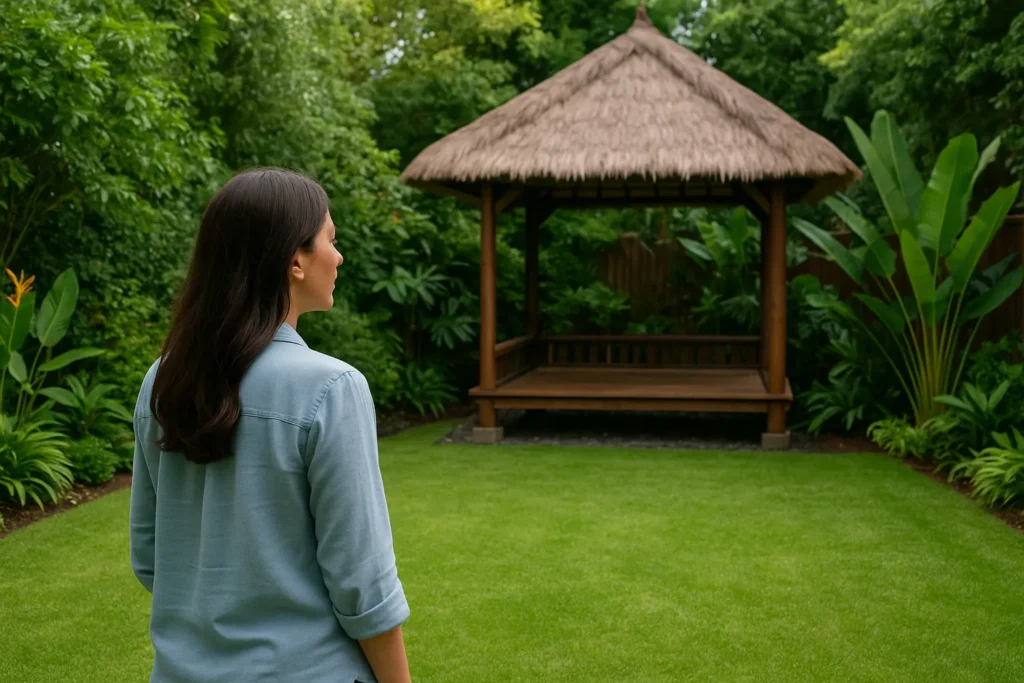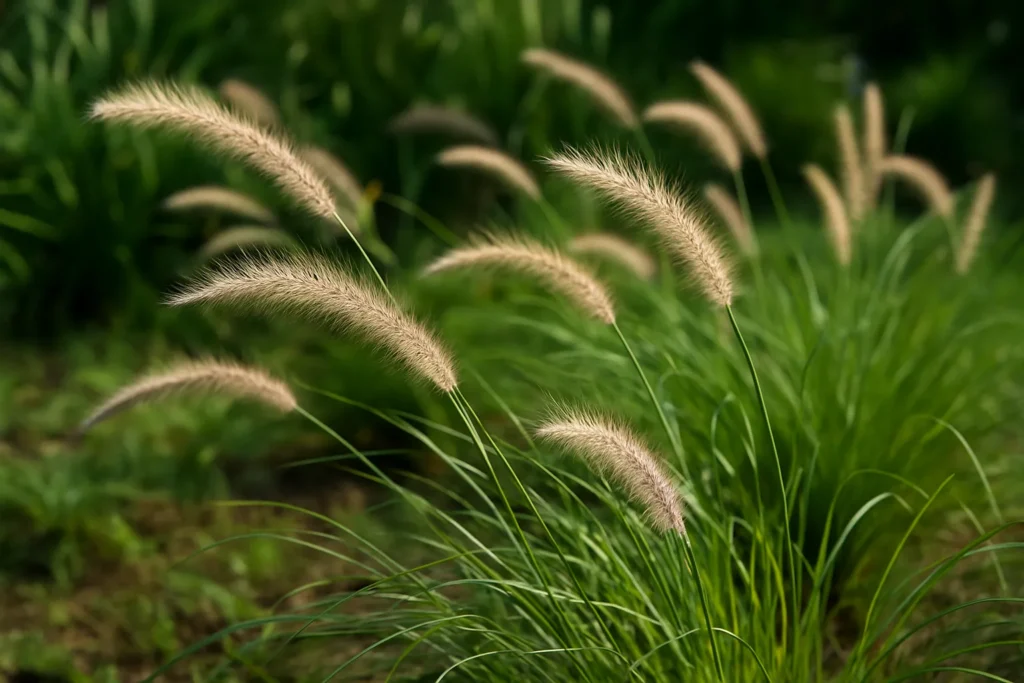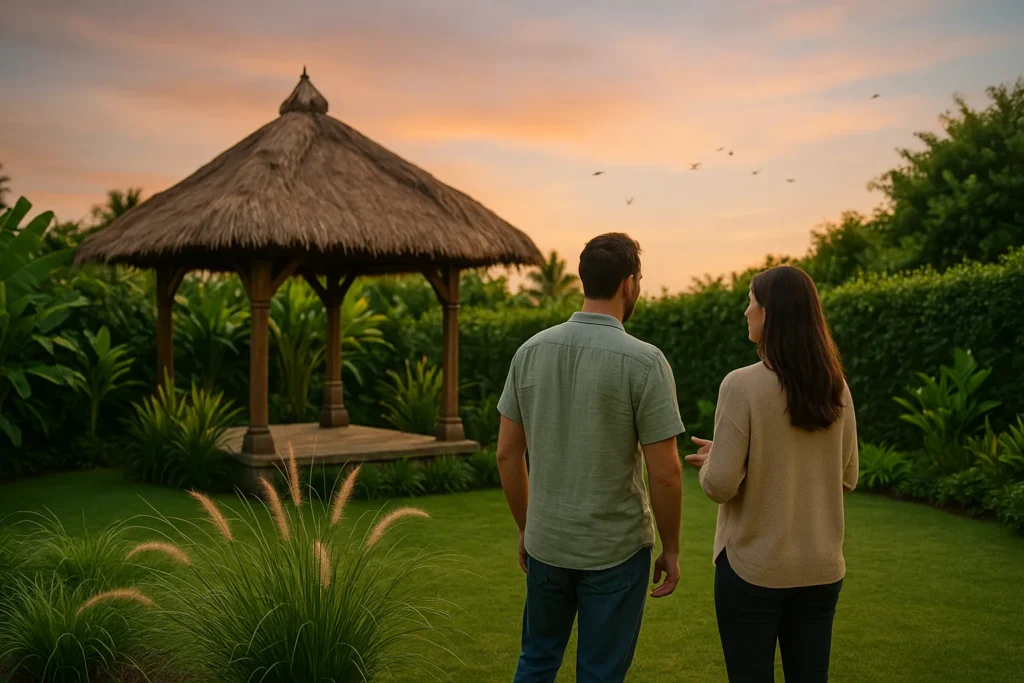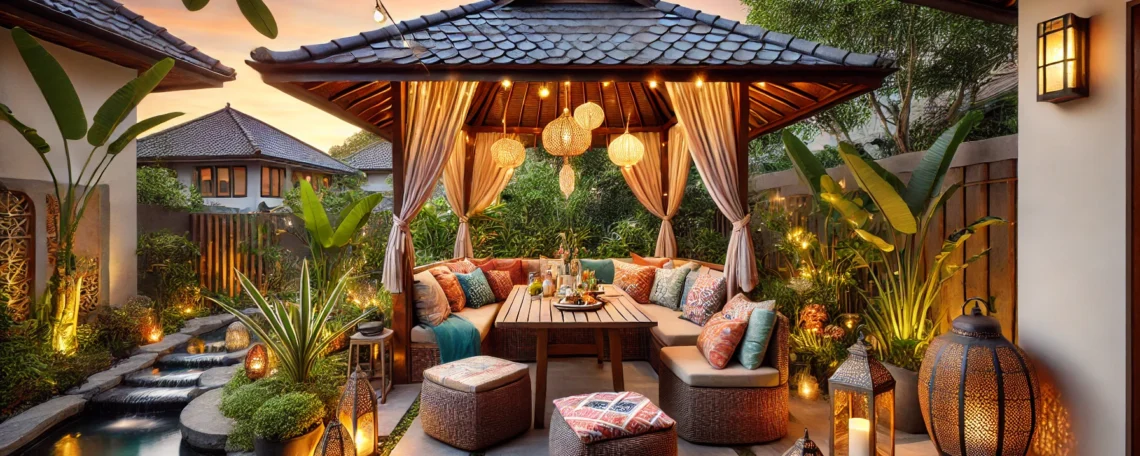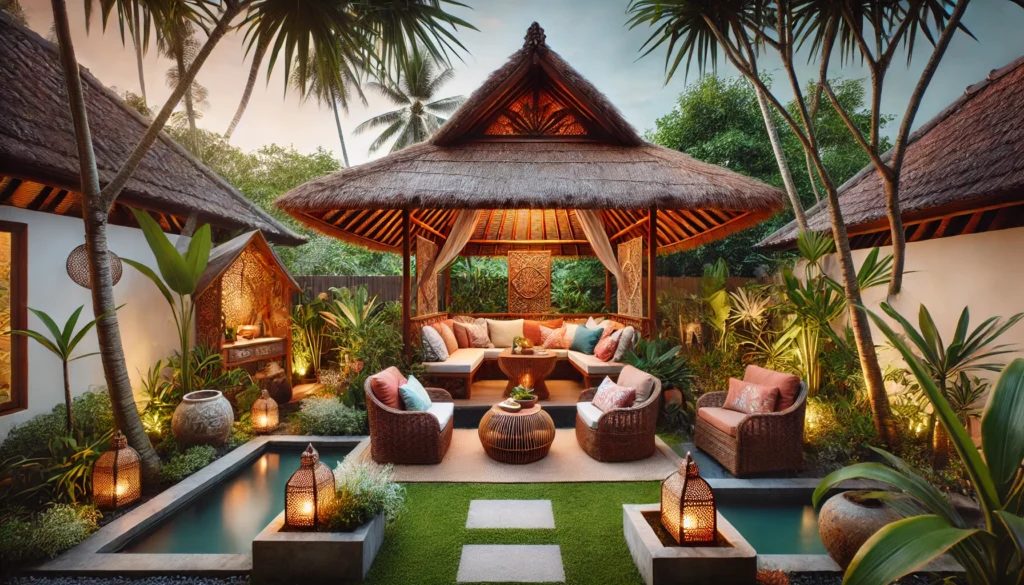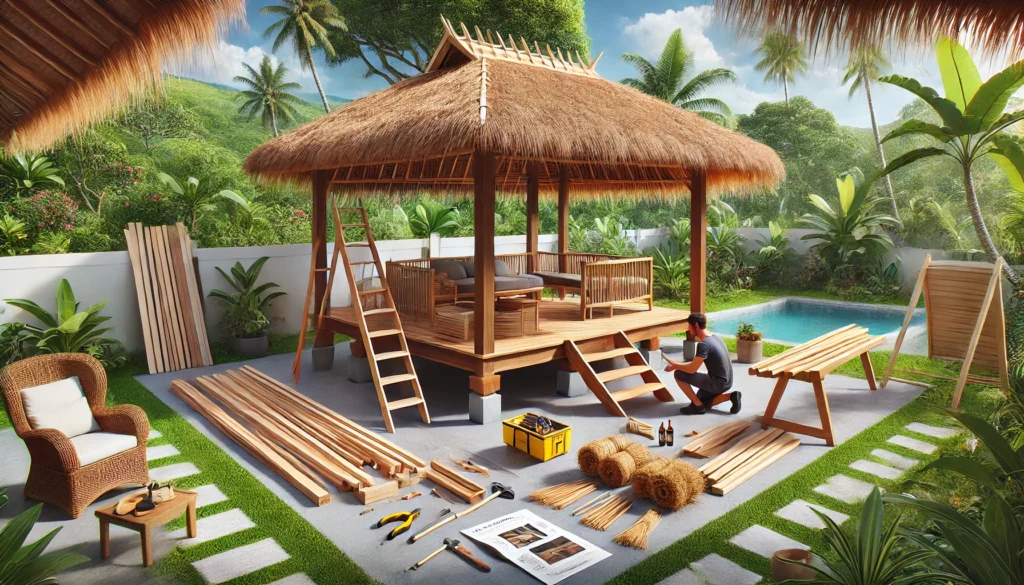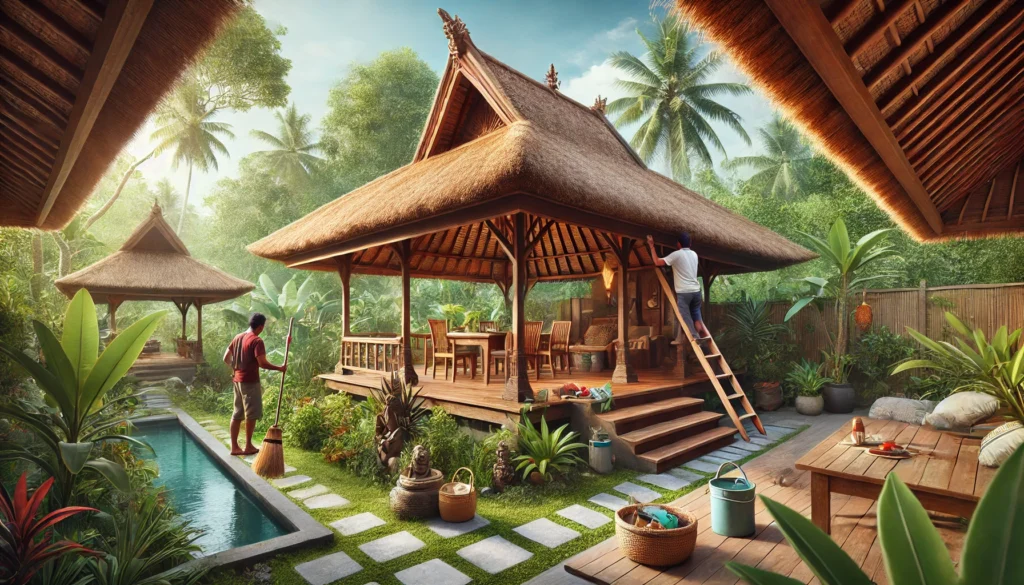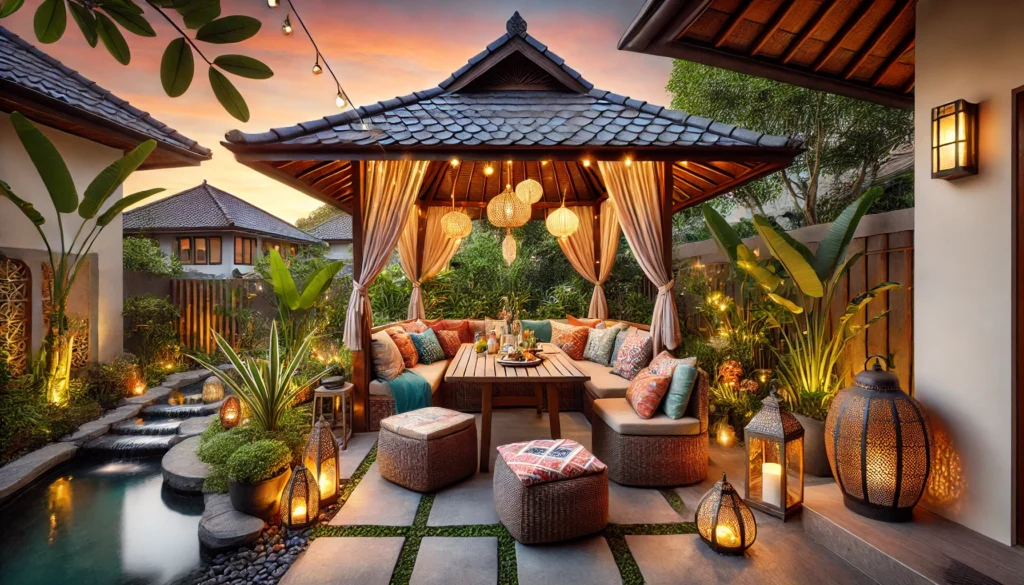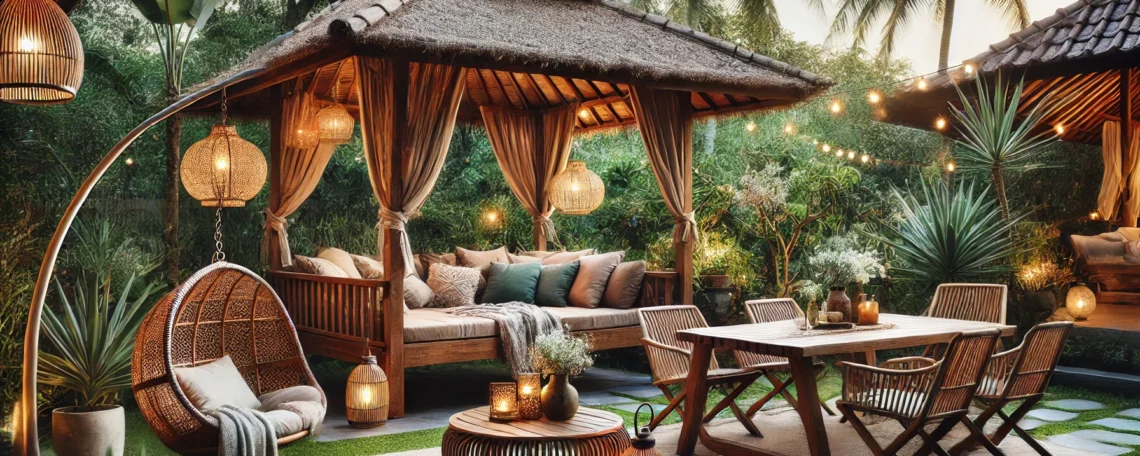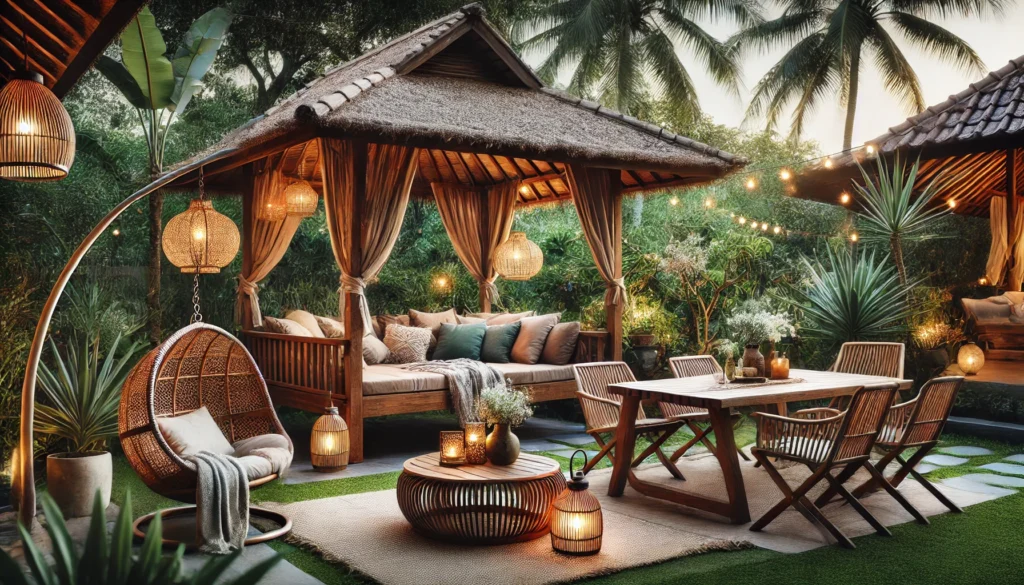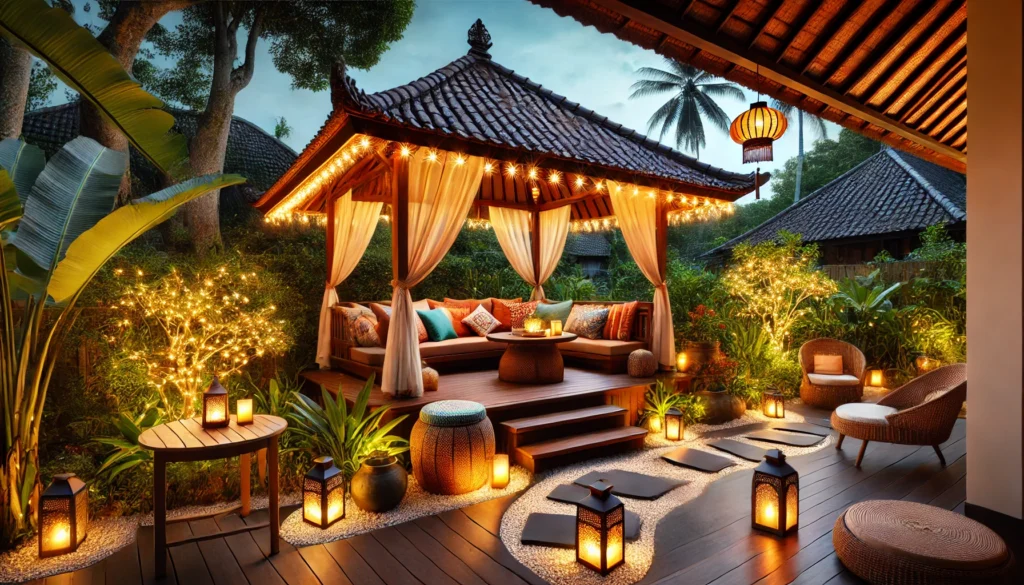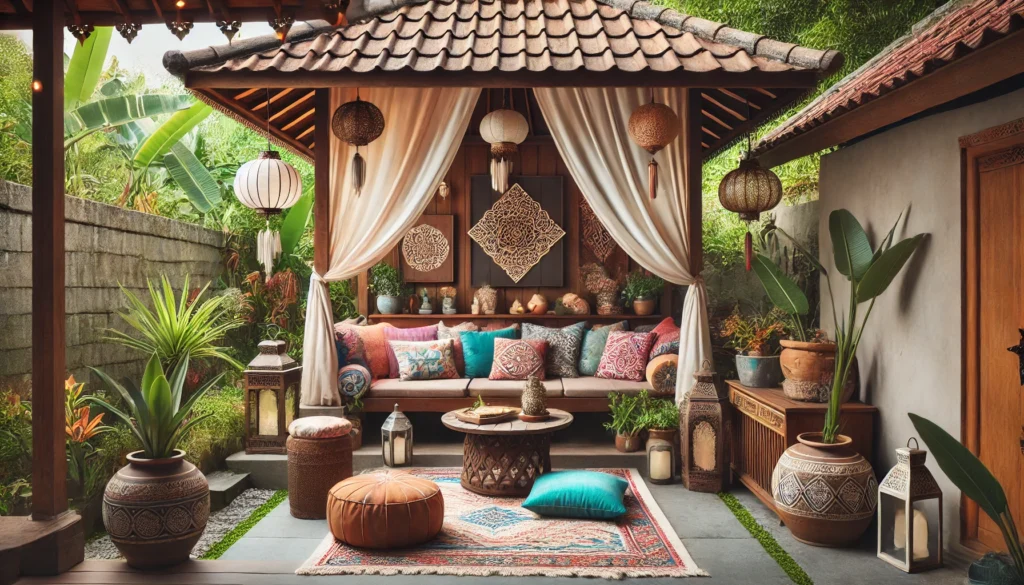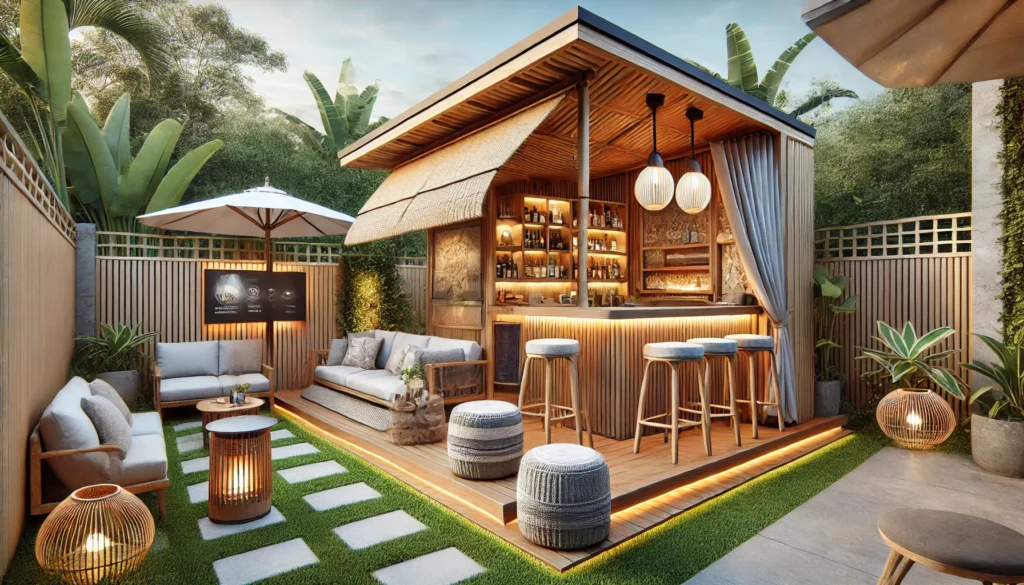Do you have a Bali hut in your backyard, but the rest of the space still feels empty and doesn’t match the tropical vibe you imagined?
Many people struggle with landscaping, especially when it comes to balancing sunlight and shade and choosing plants that work well together. Why? It’s because good landscaping needs planning, or your space won’t feel balanced or inviting.
But don’t stress. We’ll show you how to turn your backyard into a true tropical retreat.
In this guide, we’ll share simple tips on layout, plants, natural accents, lighting, and Balinese style.
Planning Your Outdoor Space: Bali Hut Layout Ideas
First, think about how your hut fits into the bigger picture. Do you want the structure to be the main feature everyone notices? Maybe you prefer a quiet hideaway tucked in a corner? Or perhaps you’re after something that connects different parts of your backyard?
Once you’ve thought about your hut’s role, it’s time to pick a layout style.
Layout Styles That Work Well
Different setups work better for different gardens and how you like to relax. Here are three popular ways to arrange your tropical garden Bali hut.
- Central Focus Layout: Put your hut right in the middle of your garden. Then you can build garden beds around it in layers. This will create a natural feel that draws people towards the perfect place to sit and unwind.
- Corner Retreat Layout: If you prefer more privacy, tuck your hut away in a quiet corner of your property. This setup gives you a private spot that’s great for reading or just escaping the heat on those really hot days.
- Poolside Cabana Layout: For those lucky enough to have a pool, set up your hut next to your pool area. You’ll get that luxury resort vibe while having shade right where you need it most.
While each arrangement has its appeal, go with the one that feels most comfortable.

Making Your Yard Shape Work For You
Your chosen layout also needs to match your garden’s natural shape. We, Georgia Wiseman, recommend trying these ideas for every layout:
- For L-shaped gardens, a corner setup creates a cozy, usable space.
- A pathway layout suits long, narrow backyards perfectly.
- Big square or rectangular gardens shine with a central focal point.
Whatever layout you choose, don’t crowd everything together around your huts. Leave some open space and clear views. This breathing room actually makes the relaxation factor work so much better.
Adding Natural Touches That Guide the Eye
To complete your layout, think about the finishing touches that tie everything together. For instance, gravel walkways, timber decking, and stepping stones help separate different areas of your backyard. These natural elements show people where to walk while adding real texture and character to your outdoor retreat ideas.
Finally, think about comfort all year round, too. Check where the sun hits during different seasons, how wind moves through your space, and where you’ll need shade in summer versus winter sun.
Once you’ve got your layout sorted and know where everything goes, it’s time to fill those carefully planned spaces with the right plants.
Low-Maintenance Tropical Plants for Your Bali Hut Garden
Most people love the idea of that amazing tropical garden look, but worry about the upkeep. Will you be stuck watering and pruning every single weekend? Hopefully not, because we’ll show you how to make a beautiful Balinese garden with minimal effort.
Plant in Strategic Layers
The secret to getting that jungle feel is thinking in layers, just like a real tropical forest. Start with tall palms as your top layer. These give you shade and that instant tropical vibe everyone wants.
Next, add some medium-height plants like cordylines and hibiscus in the middle to fill the space and add colour without blocking the hut. Then finish with low ground cover plants like mondo grass to carpet the bottom level.
Mix Local and Exotic Plants
Here’s where you can be really smart about plant choices. You can combine tough local plants with a few special exotic ones for the best of both worlds.
For example, try putting a hardy Bangalow palm next to some striking heliconia plants. Your local plants handle the tough weather while the exotic ones give you that authentic Balinese garden style you’re after.
Go for Plants That Handle Dry Spells
Bird-of-paradise and agave plants look incredibly lush but actually love hot, dry conditions. These beauties give you that tropical paradise feel without needing you to water them constantly.
Keep It Simple with Three Levels
Now, while picking out plants, try not to go overboard with too many different types. A simple three-layer approach works much better, giving your garden depth without making it look messy or crowded.
Plant in Natural Curves
You don’t want to take chances with straight lines in your planting either. Our advice is to plant in gentle curves around your Bali hut to frame views and keep your garden feeling relaxed and natural.
Add Special Touches
Now, it can’t be a tropical paradise without some special touches, can it? Pop in some traditional Balinese statues, bamboo water bowls, or eye-catching potted plants at key spots. Let these natural elements complete that authentic sanctuary feeling you’re going for.
With your plants sorted and that lush tropical backdrop in place, you’re ready to make the space actually comfortable for real life.
Outdoor Living Room Ideas: Furniture, Lighting, and Layout Tips
Once your plants are looking good, you’ll want to focus on making your outdoor retreat ideas actually work for everyday life. Here’s how to turn it into a space you’ll love using.
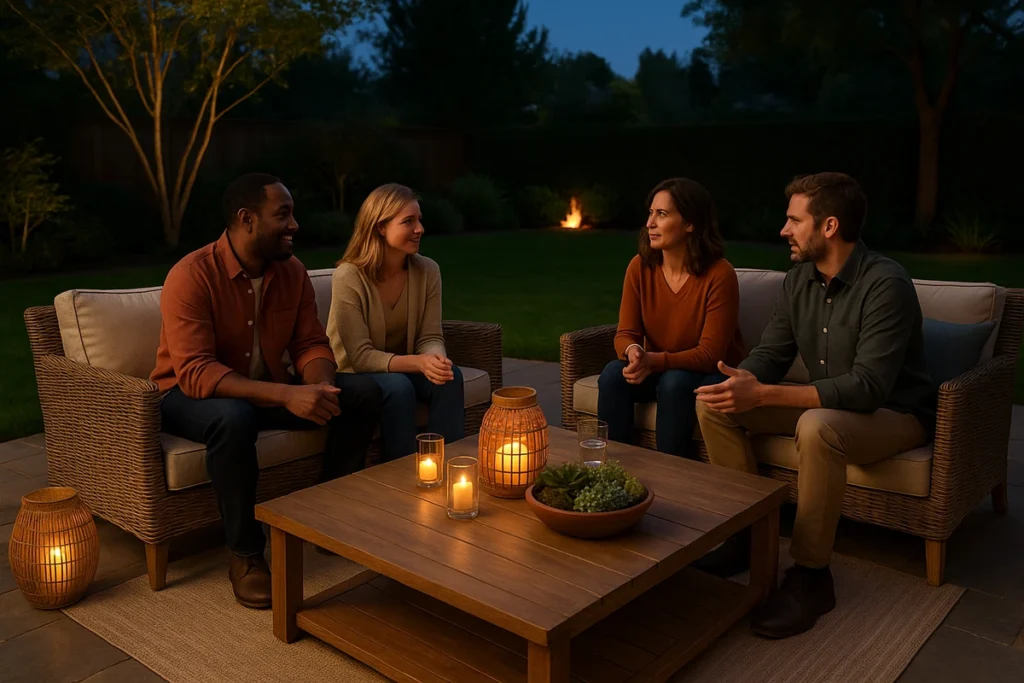
Choosing the Right Furniture
When it comes to furniture, rattan and teak pieces look amazing with the natural thatch roof and bamboo touches. These materials handle weather changes much better than regular outdoor furniture and actually get better-looking with age. Plus, woven textures give you that authentic Balinese feel while staying comfortable enough for proper relaxation.
Pairing Materials with Your Garden
When you’re picking furniture, think about how different materials work together. Stone table tops look fantastic with timber chairs and soft fabric cushions. The mix of hard and soft natural elements gives you that luxury resort feeling without looking too fancy or overdone.
Most importantly, your furniture should work nicely with your existing deck and garden materials rather than clash with them.
Setting Up Different Areas for Different Activities
Now that you’ve got your materials sorted, it’s time to think about how you’ll use the space. Your outdoor area needs to work for lots of different activities throughout the day. For example, a dining area works well closest to your house, with a sturdy table and chairs that can handle entertaining friends and family meals.
But if you like quiet time, a meditation corner fits perfectly in a tucked-away spot. Maybe just add a really comfortable single chair and a small side table there.
Smart Lighting
Once you’ve got the daytime sorted, think about good lighting for evening enjoyment.
Lights pointing up at your palms and shrubs create beautiful shadows and show off your plants at night. Pair that with soft string lights under the African thatch roof for a gentle glow, perfect for evening relaxation.

Add Sensory Touches
Finally, to really complete the experience, consider elements that work on multiple levels. Our recommendation is citronella torches because they keep bugs away naturally while adding a lovely flickering light to your space.
Make Your Bali Hut Backyard a Tropical Paradise
Ready to transform your own backyard into that tropical paradise you’ve been dreaming about?
You now have all the pieces you need to make your Balinese garden ideas come to life around your outdoor space.
Remember to keep your new sanctuary low-maintenance, functional for entertaining friends and family, and full of the sensory details that help you relax after those long, hot days. Your tropical garden Bali hut should be a perfect place where you actually want to spend time, after all.
The natural elements, tropical plants, and thoughtful design will give you a space that feels like a holiday destination right outside your back door.
